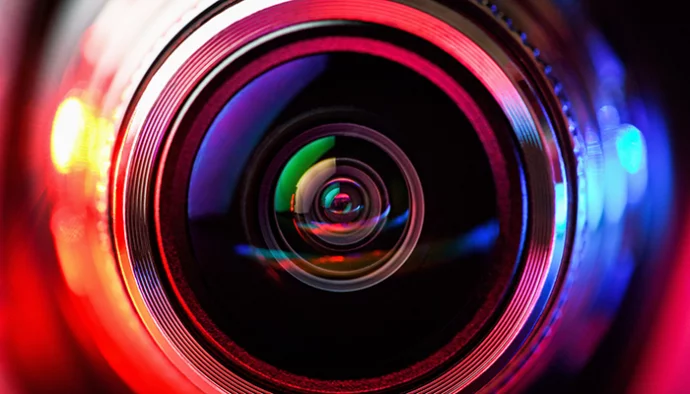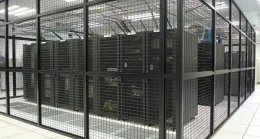Protecting Your Server Room or Data Centre with IP Cameras
Access to most server rooms is controlled and requires authorised access. Installing IP cameras can add an extra level of security and enhance the capabilities of environmental monitoring and security systems. As well as helping to monitor access and activity within the server room space, an IP camera can also store images, events and provide notification alerts.
The 5 Advantages of IP Security Cameras
An IP camera (internet protocol camera) is a digital video camera that can be connected to the local area network (Ethernet LAN or WiFi) to send and receive surveillance related information. Unlike a CCTV system, IP security cameras tend to not require a network video recorder (NVR) but can store images and data locally on their flash cards. IP cameras vary in their functionality and range from fixed view to varifocal and PTZ (pan-tilt-zoom) types.
Here are the five advantages of IP security cameras in a server room or data centre.
- Remote Monitoring: IP security cameras provide real-time remote monitoring via an IP connection including the internet. This allows data centre and IT managers to see in real time what is happening within their secure IT areas, on a 24/7 basis and from anywhere in the world. This can help to improve response times when coupled with an environmental monitoring system. Some IP cameras can also provide audible sound, one and two-way, allowing conversations and guidance to be given to local engineers.
- High-quality Video: IP cameras deliver high-resolution video, providing clear and detailed footage, which can be used to identify room intrusions, dangers to IT systems and infrastructure systems including in-room air conditioners and uninterruptible power supplies.
- Scalability: IP cameras are easy to install. Box IP cameras tend to use a mounting bracket and can be installed on a wall or wall corner where they can give maximum exposure and coverage. Dome IP cameras are generally ceiling mounted to provide a 360degree view of an area. Additional cameras are easy to install without extensive rewiring, or any additional cables at all if they ware WiFi enabled.
- Analytics and Notifications Alerts: many IP cameras offer advanced analytics and alerting features. These can include motion detection, facial recognition, and object tracking which can be setup to trigger notification emails. Camera footage can also be viewed within suitable the software packages of environmental monitoring systems such as AKCPro Server and stored against events for later analysis.
- Integration with Other Systems: IP cameras can be integrated with existing security and access control systems, seamlessly. This allows organisations to install a comprehensive and seamless access security system both for their server room or data centre, and building wide as well.
Whilst the use of IP security cameras is growing, there are some challenges to consider when looking to install the right camera.
The Challenges of Using IP Security Cameras in Server Rooms
Most of the challenges faced when selecting the right IP security camera for a server room or data centre area, centre around the fact that the cameras are IP/storage/processing devices.
- Cybersecurity and Network Vulnerabilities: as IP cameras to the local area network, they can be potential entry points for cyberattacks if not properly secured. It is vital to consider the cameras and data as part of ISO27001:2022 and Cyberessentials certifications and ensure that their firmware is always up to date with the latest patches, and use strong encryption and password policies.
- Bandwidth Considerations: as with any network device, the greater the number connected to the LAN and the larger the volume of data recorded, the larger the overhead added to network traffic and activity. The addition of any IP-enabled device should be analysed before hand to ensure that it will not slow network traffic.
- GDPR and Privacy Concerns: the use of any camera system can raise GPPR and privacy concerns. These should be covered within company policies regarding camera placement, personal data (facial/biometrics) and data handling. This should apply to both employees and sub-contractors visiting site to carry out installation and service or maintenance work within the server space.
- Maintenance and Calibration: IP cameras do require regular inspection, maintenance and potentially calibration to ensure they function correctly. Dust and environmental factors can affect the quality of video feeds and where necessary cameras should be regularly cleaned and the correct case IP-rating considered when selection is made.
The challenges discussed, generally apply to any IP-enabled device that will be added to a local or even a wide area network.
Best Practice Guide for Selecting IP Security Cameras
When it comes to selecting an IP camera for a server room or data centre, what are the top three best practices?
- Determine Your Objectives: it is important to clearly define your security needs and objectives. These could be to monitor access, detect unauthorised entry, prevent tampering or to help identify and diagnose environmental problems including high temperatures, low or high humidity levels, water leakage, smoke, or fire. Ultimately, these factors will guide the quantity and type of IP camera to be installed and their location.
- Secure Your Network: make sure that any IP cameras installed have a clear view of the space they are being used to monitor and that this view cannot be blocked. The cameras should not themselves be easily accessible and should be tamper-proof. They should be updated regularly and access securely controlled via strong password protection.
- Strategic Camera Placement: identify the critical areas and devices (server racks, air conditioners, and UPS systems) within a server room and place cameras strategically to capture important angles and areas of interest.
- Systems Integration: integrate IP cameras with access control and environmental monitoring systems to ensure that only authorised personnel can enter the server room and video images are stored and collated to relevant incidents; door entry, motion, environmental notification warning.
- Regular Maintenance: ensure that IP cameras are added to preventative maintenance schedules and are inspected regularly. This includes not just physical maintenance including camera lens cleaning but also applying firmware updates and software security patches. It is also important to dry run/test the camera system, data storage, video capture and notification alerts procedure at least once to twice a year.
- Privacy and Compliance: develop and enforce privacy policies that comply with relevant data protection regulations. Inform employees about the presence of cameras and the purpose of surveillance through written polices, permits to work and local signage.
- Data Storage and Retention: establish a clear data storage and retention policy, ensuring that video footage is retained for an appropriate duration and can be easily retrieved when needed for investigations. Even when backed-up to a cloud or local network storage device.
- Training and Awareness: provide training for the personnel responsible for monitoring and managing IP cameras, access control and environmental monitoring systems. Provide a process covering how to respond to security incidents and notification alerts.
Summary
Server rooms are an important part of today’s digital landscape and provide a central space where a company or organisation can run its critical computer and networking systems from. The installation of IP cameras provides a powerful way to improve and enhance server room security through the provision of high-quality video footage, analytics, integration, and notification alerts. They can also help to improve business continuity plans and their deployment by providing continues tracking and recording of activities.
However, the use of IP cameras within any building brings with it privacy concerns and the need to be compliant with national guidelines and laws. By following best practice such as securing the network, strategically placing cameras, systems integrations, and applying regular maintenance practices, businesses and organisations can maximise the benefits of using IP security cameras whilst mitigating any associated risks. In doing so, they can better protect their valuable assets, both physical systems and their data, and ensure the resilience and integrity of their operations in an increasingly interconnected world.
Please contact our Projects Team for more information or to discuss your IP security and monitoring project. Server Room Environments are approved partners for AXIS Communications cameras.

























